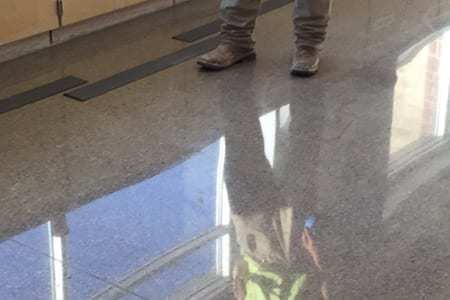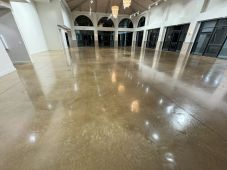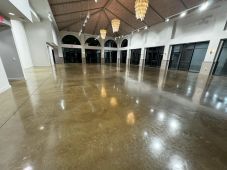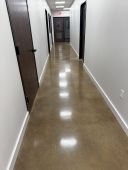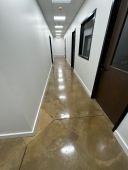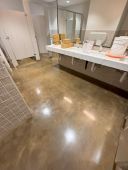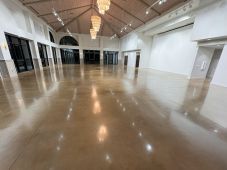Polished Concrete
AllStar Concrete Coatings provides polished concrete floors using diamond polishing, surface prep equipment, and certified concrete floor installers that you need from start to finish, to transform any decorative concrete floor into a work of art. We provide you with a sustainable flooring solution that emits little to no toxins and requires no harsh chemicals to install and maintain so you can feel good about your commercial floor investment, both in the short and long term. You can count on us to deliver a classic, modern polished concrete floor that will last for years to come.
Schedule ConsultationBenefits of Choosing AllStar Concrete Polishing
Polished Concrete provides a clean and contemporary concrete floor that complements any style.
- Guidance from knowledgeable flooring professionals on which concrete design options will work best for your project.
- Almost two decades of decorative concrete experience as one of the first companies in Central Texas working with decorative concrete flooring.
- Unparalleled customer service and a focus on taking care of even the smallest details so your diamond-polished floor stands out.
- An environmentally-friendly flooring solution that can help you qualify for LEED certification.
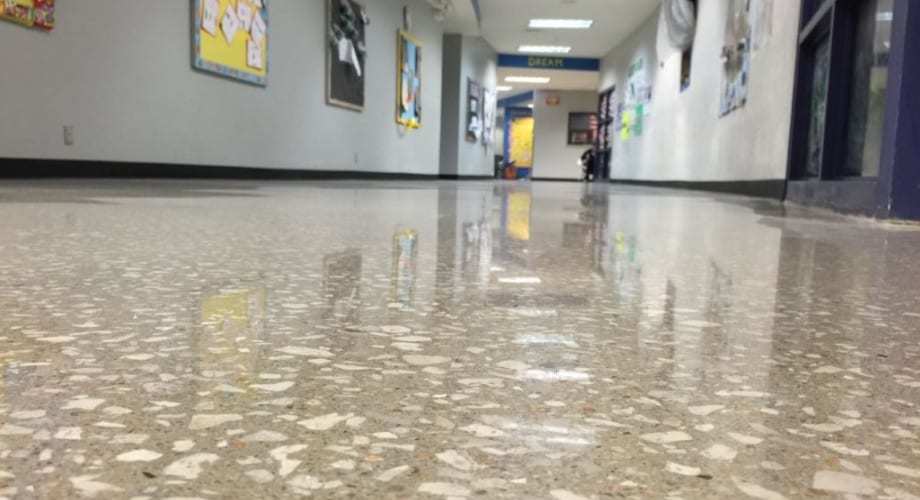
polished concrete floor austin
Some Polished Concrete Floors We Service
As Polished concrete grows in popularity, more commercial general contractors and residential builders recognize the broad number of applications for this affordable, extremely durable yet elegant type of flooring. With decades of experience delivering beautiful polished concrete Austin projects, AllStar Concrete Coatings has developed expertise in nearly every setting for this type of flooring application, including:
- Warehouse concrete floor
- Restaurant flooring
- Distribution center sealers
- Showroom floors
- School flooring
- Manufacturing facility coating
- Retail store concrete floor
- Residential polished concrete floors
Polished Concrete vs. Epoxy Floor: What’s the Best Choice?
Concrete polishing is chosen because of its:
- Wide variety of concrete dyes, floor scoring patterns, aggregate exposed floors, bands, borders, lines, grids, and other designs for your floor.
- Long life, since nothing can peel off, flake, and scratch like traditional stained concrete flooring if properly maintained.
- Minimal requirements for upkeep, since a broom and a mop, are all that you will need to clean the surfaces.
- Toughness, since the surface can resist damage from foot traffic, vehicles, and heavy equipment.
- Safety compliance, because it meets OSHA standards for slip resistance under both wet and dry conditions.
- Environmentally friendly properties that may qualify your project for LEED points.
- A bright, reflective surface that can save energy and create a clean, professional atmosphere.
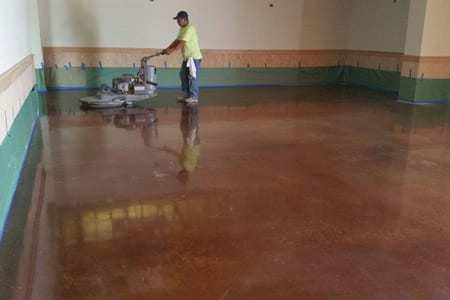
polished concrete floors in Austin, TX
How It Works
Ready to get your project started? Give us a call or fill out our Schedule Free Consultation form.
Once we learn more about what you need, including your budget and timeline, we can give you a free, no-obligation quote.
After you review and approve our estimate, we will contact you to review all of the details of your project and to get you on our schedule to reserve the services, contractors, and equipment you’ll need.
Before the project begins, we’ll be in regular contact so that we can complete the job in the agreed-upon time frame.
The steps of a typical polished concrete project are as follows:
- Conduct a detailed inspection of the condition of the existing concrete floor surface.
- Remove any existing concrete sealer, and epoxy floor coverings, and surface prep the floor to prepare for your desired flooring solution.
- Fill in any expansion joints, control joints, crack repair, spalled concrete, or other imperfections.
- Grind your existing concrete surface with specialized surface prep equipment and diamond-bonded abrasives.
- Apply acid stains, water-based stains, or concrete dyes if color is requested.
- Continue the polishing process with different diamond polishing pads, as needed, until the concrete reaches the desired sheen.
- Apply an impregnating sealer/ liquid densifier to protect, dustproof, and harden your surface and make it denser.
- Apply a concrete polish guard and propane burnish to protect the surface from spills and staining.
Our project foreman will be your primary contact during the job is available to answer questions and will supervise our trained and experienced craftsmen. Our crews come with all the supplies and equipment they need to meet your timeline and budget. We can even supply our power if needed.
After the work has been done, we will schedule a walk-through to go over the process and provide you with information about the care and maintenance of your new flooring.
What is Polished Concrete?
Polished concrete is a sophisticated and versatile flooring option that combines durability, aesthetics, and cost-effectiveness. It involves the mechanical grinding and polishing of a concrete surface, which is then treated with chemical densifiers. The process transforms an ordinary concrete slab into a shiny, high-gloss finish that resembles polished stone. This type of flooring is not only about enhancing the visual appeal but also about improving the concrete’s performance and longevity.
Definition and Overview
Polished concrete is achieved through a series of mechanical grinding and polishing steps. The process begins with the use of coarse diamond segments bonded in a metallic matrix. These segments are responsible for eliminating minor pits, blemishes, stains, or light coatings from the floor. As the procedure progresses, the diamond grit becomes finer, smoothing the concrete surface to the desired level of sheen and smoothness. During the process, chemical hardeners are often applied to the concrete surface to densify and fill the pores, thus increasing its strength and dust-proofing the surface.
The final product is a sleek, reflective surface that offers a range of finishes – from satin to high gloss – making it suitable for a variety of applications. Its durability and low maintenance requirements make polished concrete an increasingly popular choice for commercial facilities, warehouses, and residential homes alike.
Brief History and Evolution of Polished Concrete
The history of polishing concrete floors dates back to the 1990s when it was first introduced as a viable flooring option. Initially, the process was rudimentary and labor-intensive, involving the use of basic grinding tools and equipment. However, the potential for achieving a durable, low-maintenance flooring solution was quickly recognized.
As technology advanced, so did the techniques and equipment used in polishing concrete. The introduction of industrial-grade diamond grinding machines revolutionized the process, allowing for the production of smoother and more consistent surfaces. Chemical densifiers, which were introduced later, added to the durability and longevity of polished concrete floors by sealing the pores and increasing the surface density.
In the 21st century, polished concrete has evolved into a fully customizable flooring option. Advancements in polishing equipment and techniques now allow for a variety of colors, patterns, and designs to be incorporated into the floor. This adaptability, combined with the inherent benefits of concrete, has solidified polished concrete’s reputation as a high-performance, aesthetically versatile flooring solution.
Today, polished concrete is not just a trend; it’s a sustainable flooring option that beautifully marries functionality with elegance. Its evolution continues as techniques and technologies develop, pushing the boundaries of what can be achieved with a simple concrete slab.
Types of Polished Concrete
Polished concrete flooring stands out for its versatility and customization options. One of the primary choices to make during the polishing process is the level of concrete aggregate exposure, which defines the final appearance of the floor. Among these options, Cream Polish is a popular and elegant choice.
Cream Polished Concrete
Description and Characteristics
Cream Polish refers to the smoothest and most consistent finish you can achieve with polished concrete. This finish is attained by gently polishing the cream layer – the topmost layer of the concrete slab, which consists of the cement paste and fine sand. As the name suggests, Cream Polish results in a creamy and uniform texture without exposing any of the underlying sand and aggregates.
The Cream Polish finish is known for its subtlety and sophistication. It showcases the natural beauty of concrete in its purest form, providing a solid color with minimalistic yet refined aesthetic appeal. The finish is smooth to the touch and offers a high level of shine, capable of reflecting light to brighten up indoor spaces.
Ideal Use Cases
Cream Polish is ideal for areas where a sleek, modern, and elegant look is desired. Its smooth and consistent finish makes it a perfect choice for:
- Residential Spaces: Homes that aim for a minimalist or contemporary interior design can greatly benefit from the clean and sophisticated look of Cream Polish. It’s particularly popular in living rooms, kitchens, and open-plan areas where the reflective surface can make spaces appear larger and more open.
- Commercial and Retail Spaces: The high-gloss and refined appearance of Cream Polish flooring is suitable for showrooms, galleries, and high-end retail stores where the aesthetic of the floor can complement and enhance the displayed products.
- Office Buildings: For corporate environments that require a professional and clean look, Cream Polish provides a subtle yet impressive flooring solution. Its reflective surface can also help in reducing the need for artificial lighting, promoting a brighter and more inviting workspace.
- Healthcare and Educational Institutions: Due to its non-porous and easy-to-clean nature, Cream Polish is an excellent option for environments that prioritize hygiene and low maintenance, such as hospitals, clinics, and schools.
Cream Polish is a testament to the elegance and versatility of polished concrete, offering a range of applications where both aesthetics and functionality are key considerations. Its timeless appeal makes it a preferred choice for many who wish to combine durability with a touch of sophistication.
Salt and Pepper Polished Concrete
Salt and Pepper Polish is a distinctive polished concrete style that offers a balanced blend of subtlety and texture. It garners its name from the speckled pattern created by lightly exposing the fine aggregates or sand particles in the concrete mix, reminiscent of sprinkled salt and pepper.
Description and Characteristics
- Moderately Textured Surface: Unlike Cream Polish, Salt and Pepper Polish involves slightly grinding down the concrete surface to expose the small aggregates or sand particles, resulting in a lightly speckled and textured appearance.
- Versatile Aesthetic Appeal: This finish provides a neutral yet visually interesting backdrop that can complement various interior design themes. The degree of aggregate exposure can be controlled to achieve the desired level of speckle and texture.
- Durability with Aesthetic Flair: Salt and Pepper Polish retains polished concrete’s inherent durability and low maintenance characteristics while adding a unique aesthetic dimension to the floor.
- Customizable Gloss Levels: Similar to other polished concrete finishes, the Salt and Pepper Polish can be customized in terms of sheen, ranging from a matte to a high-gloss finish, according to the specific requirements of the space.
Ideal Use Cases
Salt and Pepper Polish is versatile, making it an excellent choice for various settings that seek a balance between understated elegance and a touch of character.
- Commercial and Retail Environments: Ideal for stores, cafes, and restaurants, the Salt and Pepper Polish offers a durable surface that withstands high traffic while providing an aesthetically pleasing and welcoming ambiance.
- Residential Spaces: Homeowners looking for a flooring option that is both stylish and practical find the Salt and Pepper Polish an attractive choice. It works well in kitchens, living rooms, and other areas where a blend of durability and design is desired.
- Office and Corporate Spaces: The professional and clean look of Salt and Pepper Polish suits office buildings and corporate facilities, offering a floor that is easy to maintain and reflects a sense of sophistication and attention to detail.
- Artistic and Creative Studios: For spaces that require a backdrop that is both inspiring and unobtrusive, the subtle texture and neutral tones of the Salt and Pepper Polish provide an ideal canvas.
Salt and Pepper Polish stands out for its ability to introduce texture and visual interest to a space without overwhelming the overall design. It’s a testament to the versatility and adaptability of polished concrete, catering to a wide range of aesthetic preferences and functional requirements.
Customized Designs
In the realm of polished concrete, the option for customized designs opens a world of possibilities for personalization and creative expression. Beyond the traditional finishes, custom designs allow individuals and businesses to imprint their unique style and identity onto their floors, making each space distinct and memorable.
Description and Possibilities
Customized designs in polished concrete go beyond the choice of aggregate and level of sheen. They involve a variety of techniques and materials that can be used to create intricate patterns, vivid colors, and complex artistic imagery. Here are some possibilities that customized polished concrete designs offer:
- Stained Concrete: Acid or water-based stains can be applied to the concrete to add vibrant colors or subtle hues, creating a rich tapestry of color that complements the interior design.
- Dyed Concrete: Concrete dyes offer a wider color palette and can produce more intense and varied shades, allowing for more vivid and intricate design work.
- Engraved Designs: Special tools can be used to engrave patterns, logos, or intricate designs into the concrete, adding a level of sophistication and branding to the space.
- Embedded Objects: During the pouring stage, items such as glass pieces, stones, or metal can be embedded into the concrete, providing unique textures and light-reflective properties.
- Polished Overlays: For an existing concrete floor, polished overlays can be applied, offering a new canvas for color and design while maintaining the benefits of polished concrete.
How to Choose the Right Design
Selecting the right design for your polished concrete floor involves considering several factors to ensure that the final product aligns with your aesthetic preferences, functional needs, and overall design vision. Here are some steps to guide you in choosing the right design:
- Understand the Purpose of the Space: Consider the function of the area where the polished concrete will be installed. High-traffic areas may require more durable finishes, while spaces for relaxation or display might focus more on aesthetic appeal.
- Consider the Overall Design Theme: The polished concrete should complement the interior design of the space. Consider how colors, patterns, and textures can harmonize with walls, furniture, and other design elements.
- Reflect on Branding or Personal Style: For businesses, the floor design can be an extension of the brand, incorporating logos or colors associated with the company. For homes, it can reflect personal style or artistic taste.
- Consult with Professionals: Engage with design professionals or contractors who specialize in polished concrete. They can provide insights into the latest trends, techniques, and materials, as well as offer practical advice on what works best for your specific situation.
- Review Samples and Portfolios: Before making a final decision, review samples of polished concrete finishes and portfolios of completed projects. This can provide a tangible sense of the look and feel of different design options.
- Consider Maintenance and Longevity: While aesthetics are important, also consider the maintenance requirements and durability of the chosen design, especially in areas subjected to heavy use or extreme conditions.
Customized polished concrete designs offer an exciting opportunity to create a space that truly reflects individual style and purpose. By carefully considering your options and working with experienced professionals, you can ensure that your polished concrete floor is as unique as the space it inhabits.
Benefits of Polished Concrete
Polished concrete floors are renowned not just for their aesthetic appeal but also for a multitude of practical benefits. These advantages make polished concrete an increasingly popular choice across various industries and residential settings. Below are the key benefits, along with comparisons to other flooring materials, maintenance tips, and insights into their cost-effectiveness and environmental friendliness.
Durability and Longevity
- Highly Resistant to Wear and Tear: Polished concrete floors are incredibly durable and can withstand high traffic, heavy loads, and harsh conditions without deteriorating.
- Long Lifespan: When properly installed and maintained, polished concrete floors can last for decades, outlasting many other flooring options.
- Comparison with Other Flooring Materials: Unlike carpet, wood, or vinyl that can wear, tear, or warp over time, polished concrete maintains its integrity and appearance, requiring no replacement or frequent repairs.
Low Maintenance
- Ease of Cleaning: Polished concrete doesn’t harbor dust, dirt, allergens, or mold, making it easy to clean through regular sweeping and occasional mopping with a neutral cleaner.
- Reduced Maintenance Costs: Unlike flooring that requires waxing, stripping, or refinishing, polished concrete needs minimal upkeep, saving on maintenance costs over time.
- Cleaning and Maintenance Tips: Use microfiber pads for dust mopping, clean spills immediately to prevent staining, and avoid using harsh chemicals that can damage the polished surface.
Aesthetic Appeal
- Versatile Designs and Finishes: Polished concrete offers a range of finishes from satin to high gloss and can be integrated with colors, patterns, and textures to complement any design aesthetic.
- Enhances Ambient Lighting: The reflective surface of polished concrete can significantly increase the brightness of a space, reducing the need for artificial lighting.
- Case Studies or Photo Gallery: Showcase real-life examples of polished concrete in various settings to illustrate its adaptability and aesthetic potential.
Cost-Effectiveness
- Low Installation Costs: Compared to other high-end flooring options, polished concrete is often less expensive to install, especially if the building already has a concrete slab.
- Long-term Financial Benefits: The longevity and low maintenance requirements of polished concrete make it a cost-effective flooring solution over its lifespan.
- Value Addition: Polished concrete floors can increase the value of a property due to their durability, low maintenance, and timeless appeal.
Environmentally Friendly
- Sustainability Aspects of Polished Concrete:
- Resource Efficiency: Utilizes the existing concrete slab, reducing the need for new materials.
- Energy Efficiency: The reflective surface can reduce the need for artificial lighting and help maintain consistent indoor temperatures.
- Low VOC Emissions: Unlike some flooring options, polished concrete does not off-gas harmful volatile organic compounds (VOCs), contributing to better indoor air quality.
- Long Lifecycle: Reduces the frequency of flooring replacements and the associated environmental impact.
Polished concrete flooring stands out for its unparalleled durability, low maintenance, aesthetic versatility, cost-effectiveness, and environmental benefits. These attributes make it an ideal choice for anyone looking to combine style with practicality in their flooring solution.
Industries Benefiting from Polished Concrete
Polished concrete flooring, with its myriad of benefits, has gained widespread popularity across diverse industries. Its durability, aesthetic appeal, and low maintenance make it an ideal choice for various settings. Below, we explore how different industries benefit from this versatile flooring solution, accompanied by case examples.
Commercial and Retail
- Benefits: In commercial and retail spaces, polished concrete withstands heavy foot traffic, provides an upscale look without extensive maintenance, and reflects light to make spaces appear brighter and more inviting.
- Case Examples: High-end retail stores utilize polished concrete to create a sleek backdrop for merchandise, while restaurants and cafes enjoy the easy-to-clean and hypoallergenic surface that maintains a hygienic environment.
Industrial and Warehouses
- Benefits: Industrial settings value polished concrete for its durability and resistance to heavy machinery, stains, and spills. The flooring’s light-reflective nature also contributes to a safer and more energy-efficient workspace.
- Case Examples: Warehouses benefit from polished concrete’s ability to withstand the constant movement of goods and machinery, reducing the need for frequent repairs and maintenance while manufacturing plants appreciate the floor’s resistance to oil, grease, and chemical spills.
Residential
- Benefits: Homeowners choose polished concrete for its modern look, longevity, and ease of maintenance. It offers a customizable flooring solution that can mimic the look of more expensive materials at a fraction of the cost.
- Case Examples: In residential homes, polished concrete is often used in living rooms, kitchens, and basements, providing a durable surface that resists scratches, stains, and moisture while adding a touch of elegance to the home.
Healthcare and Educational Institutions
- Benefits: Healthcare and educational facilities benefit from polished concrete’s hygienic surface, which does not harbor dust, allergens, or pathogens, contributing to cleaner air quality. Its durability withstands high traffic, and the reflective surface maximizes natural light, creating a bright and inviting atmosphere.
- Case Examples: Hospitals and clinics utilize polished concrete in patient rooms and corridors for its easy-to-clean surface and modern appearance, while schools and universities appreciate the floor’s resilience to constant foot traffic and its contribution to a focused, well-lit learning environment.
Polished concrete floors offer a blend of functionality, durability, and aesthetic appeal that suits the diverse needs of various industries. From enhancing the shopping experience in retail spaces to supporting the hygienic requirements in healthcare facilities, polished concrete proves to be a versatile and beneficial choice for a multitude of settings.
Pros and Cons of Polished Concrete
While polished concrete flooring offers a host of benefits and has become a popular choice for various applications, it’s essential to consider both its advantages and potential drawbacks. A balanced view will help in making an informed decision. Below is a detailed list of the pros and cons of polished concrete, along with a comparative analysis with other popular flooring options.
Pros of Polished Concrete
- Durability: Polished concrete is extremely hard-wearing and can withstand heavy traffic and industrial wear and tear without deteriorating.
- Low Maintenance: It requires minimal upkeep. Regular dust mopping and occasional damp mopping are generally sufficient to keep the floor looking its best.
- Longevity: When properly installed and maintained, polished concrete floors can last for decades.
- Cost-Effective: Lower installation and maintenance costs compared to many other flooring options make it an economical choice in the long run.
- Aesthetic Appeal: Offers a range of finishes and can be integrated with colors, patterns, and designs to complement any interior.
- Reflectivity: The reflective surface of polished concrete enhances ambient lighting, contributing to a bright and inviting atmosphere.
- Environmentally Friendly: Polished concrete is a sustainable option, especially when using an existing concrete slab. It does not require the production of new materials and is free from harmful VOC emissions.
Cons of Polished Concrete
- Hardness: While its hardness contributes to durability, it can also be less comfortable to stand on for prolonged periods. This can be mitigated by using mats in areas where people stand for long durations.
- Slipperiness: Polished concrete can be slippery when wet. Applying anti-slip conditioners or treatments can enhance the slip resistance of the surface.
- Coldness: Concrete can feel cold underfoot, particularly in winter. This can be offset by incorporating radiant heating systems or using area rugs.
- Moisture Sensitivity: If not properly sealed, polished concrete can be susceptible to moisture penetration, especially from the ground. Proper installation and sealing are crucial to prevent this issue.
- Aesthetic Limitations: While polished concrete is versatile, it may not suit the style of every space or individual’s preference.
Comparative Analysis
Compared to other popular flooring options like hardwood, tile, carpet, and vinyl, polished concrete stands out for its durability, low maintenance, and cost-effectiveness. Unlike carpet and hardwood, it doesn’t harbor allergens or succumb to wear patterns. Unlike tile, it doesn’t have grout lines that can become dirty or discolored. However, it doesn’t naturally provide the warmth of carpet or the sound-dampening qualities of softer materials, though this can be remedied with rugs and acoustic treatments.
In essence, polished concrete is a practical, versatile, and aesthetically flexible flooring option, well-suited for a variety of settings. Its benefits in terms of durability, maintenance, and aesthetics are substantial, though it’s also important to consider its hardness, potential slipperiness, and other characteristics when deciding if it’s the right choice for a specific application.
How to Polish Concrete
The installation of polished concrete is a meticulous process that involves several critical steps. Proper execution at each stage ensures the durability, appearance, and longevity of the flooring. Below is an overview of the installation process, including pre-installation considerations, a step-by-step guide to the installation, and tips for post-installation care and maintenance.
Pre-installation Considerations
- Assess the Condition of the Concrete: The current condition of the concrete slab should be thoroughly assessed. Any cracks, flaws, or inconsistencies need to be addressed before proceeding.
- Moisture Test: Conduct a moisture test to ensure that the concrete slab does not have a high moisture content, which can affect the adhesion of stains, dyes, or sealers.
- Determine the Finish Level: Decide on the level of aggregate exposure and the desired gloss level. This will dictate the grinding process and the number of grinding passes.
- Check for Flatness and Levelness: Ensure that the floor is flat and level to avoid uneven polishing.
- Environmental Conditions: Check the temperature and humidity levels. Ideal conditions are necessary for certain products, such as sealers, to cure properly.
Step-by-Step Installation Guide
- Preparation: Remove any existing coatings, adhesives, or impurities from the concrete surface. Repair cracks or holes with an appropriate concrete repair material.
- Initial Grinding: Start with a coarse diamond grinding pass to remove any blemishes or light coatings and to expose the desired level of aggregate.
- Grouting: Fill any pinholes or small imperfections with a grout or slurry, which is a mixture of cement and water.
- Further Grinding and Polishing: Proceed with finer grits of diamond tooling to smooth the concrete surface. Typically, the process moves from coarse grinding to fine polishing.
- Chemical Hardener Application: Apply a chemical hardener to densify and harden the concrete surface, making it more durable and stain-resistant.
- Final Polishing: Perform the final polishing pass, using the finest grit to achieve the desired sheen level – from satin to high gloss.
- Sealer Application: Apply a sealer to protect the polished surface and to enhance its color and luster.
Post-installation Care and Maintenance
- Regular Cleaning: Dust mop or sweep the floor regularly to remove grit and debris. Clean spills promptly to prevent staining.
- Damp Mopping: Use a clean mop and clean water, possibly with a pH-neutral cleaner, to clean the floor. Avoid harsh chemicals that can damage the floor’s finish.
- Refinishing if Necessary: Depending on the level of traffic and wear, the polished concrete may need to be re-polished or have its sealer reapplied periodically.
- Protective Mats: Use mats in high-traffic areas or in places where water might be spilled frequently, such as near sinks or drinking fountains.
Properly installed and maintained polished concrete floors can last for many years, providing a durable, aesthetically pleasing, and practical flooring solution.
Case Studies and Testimonials
Polished concrete has transformed numerous spaces, providing both aesthetic beauty and functional benefits. Below are case studies from industry experts and clients who have experienced the transformational impact of polished concrete in various settings.
Commercial Retail Space
- Background: A high-end retail store wanted a flooring solution that reflected its brand’s sophistication and elegance while withstanding heavy foot traffic.
- Solution: The store opted for a Salt and Pepper Polish with a high-gloss finish, providing a sleek backdrop that made their merchandise stand out.
- Outcome: The floor has not only enhanced the aesthetic appeal of the store but has also proven to be durable and easy to maintain, even with high customer traffic.
Industrial Warehouse
- Background: An industrial warehouse needed a floor that could endure heavy machinery, frequent spills, and constant traffic without requiring extensive maintenance.
- Solution: A Full Aggregate Polish was implemented, providing a highly durable surface resistant to stains, spills, and wear.
- Outcome: The warehouse floor has maintained its integrity and appearance, reducing the need for repairs and maintenance.
Residential Property
- Background: A homeowner desired a modern, easy-to-maintain floor that complemented their open-plan living space.
- Solution: They chose a Cream Polish with a satin finish, offering a modern look that seamlessly integrated with their home’s design.
- Outcome: The polished concrete floor has provided a durable, low-maintenance, and beautiful surface that has become the centerpiece of their home.
Healthcare Facility
- Background: A healthcare facility requires a hygienic, easy-to-clean floor that contributes to a calm and healing environment.
- Solution: A Cream Polish with an anti-slip finish was selected, ensuring a hygienic, safe, and soothing environment for patients and staff.
- Outcome: The floor has significantly contributed to the facility’s cleanliness and overall serene atmosphere.
These case studies and testimonials highlight the versatility, durability, and aesthetic appeal of polished concrete, making it a preferred choice across diverse industries. Each story highlights how polished concrete can be tailored to meet specific needs, ensuring not just a flooring solution, but an enhancement to the overall space.
Conclusion
Polished concrete stands out as a versatile, durable, and aesthetically appealing flooring option that caters to a wide array of settings and preferences. From high-end retail spaces to industrial warehouses, residential homes, and healthcare facilities, its benefits are extensive and varied. Its ability to withstand heavy traffic, low maintenance requirements, and customizable nature make it an ideal choice for anyone seeking a flooring solution that combines practicality with elegance.
Summary of Key Points
- Durability and Longevity: Polished concrete floors are incredibly hard-wearing, and capable of withstanding heavy use without deteriorating, making them a long-lasting solution for any space.
- Aesthetic Versatility: With options ranging from Cream Polish to Full Aggregate Polish and the ability to integrate colors and designs, polished concrete can complement any interior design aesthetic.
- Low Maintenance: These floors are easy to clean and maintain, requiring minimal effort to keep them looking pristine over the years.
- Cost-Effectiveness: The initial installation and long-term maintenance costs of polished concrete are generally lower compared to other flooring options, offering a cost-effective solution without compromising on quality or appearance.
- Environmental Sustainability: Polished concrete is an environmentally friendly choice, utilizing existing materials, reducing the need for new resources, and maintaining excellent indoor air quality with low VOC emissions.
As we’ve explored the myriad of benefits and applications of polished concrete, it’s clear that this flooring option is not just a practical choice, but also a statement of style and sustainability. Whether you’re renovating a space or embarking on a new project, polished concrete offers a durable, beautiful, and cost-effective solution that stands the test of time.
Schedule ConsultationOur team of experts is here to guide you through every step of the process, from choosing the right finish to ensuring a flawless installation. Contact us today to schedule a consultation and discover how polished concrete can elevate the aesthetics and functionality of your space.
Free Consultation
Ready to learn more about how AllStar can help you? Take advantage of our free consultation to get the ball rolling.
Get Started

